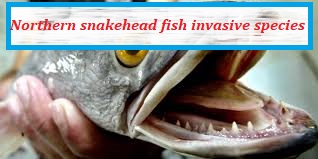 |
| Northern snakehead fish invasive species |
Northern snakehead fish invasive species
So far, they have appeared in water from Massachusetts to California and Manhattan's Central Park to Arkansas for a couple's sake. The largest group is in and around the Chesapeake Bay, and authorities in Maryland and Virginia have taken different routes to try to interfere with the Gulf's fragile ecological balance.
The risk of snakehead, which is believed to be spawned repeatedly during the year, unlike other species, is that it is a hearty newcomer that can squeeze out long-established and more desirable fish.
A native of China's Yangtze River Basin, the so-called "Frankenfish" made its first major media splash in the United States in 2002, when a thriving population was discovered in a Maryland pond outside Washington.
Read more: Northern snakehead fish invasive species - Northern snakehead fish, invasive species, cannot be considered inherently evil.
Fondly known as Channa Argus or "Lightning Perch", they were specified to be able to wipe out native species and "walk" on land for no natural predators.
Many other non-native fish have flourished in the United States, but some rival to northern snakes: as long as 30 inches (76 cm) or more, the fish has a large, jagged mouth and is out of the water for several days. Can survive till To smuggle and hide an entire body. It is a delicacy in Asia and is gaining a following among cooks in the United States.
Virginia fishery biologist John Odenkirk said intelligent management - not eradication - is the goal of his state to hunt snakes. So far, the fish have not wreaked havoc with the Potomac River ecosystem, he said on a recent survey trip through Virginia streams.
The population of the snakehead has increased since 2004. But the population of such a large-mouth bass is a prized regional game fish that takes $ 622 million a year in Virginia and is responsible for more than 5,500 jobs in the state according to the American Sporting Association. .
"It's a tough fish," Odenkirk said as he pulled a vigorous 32-inch-long snake into the stomach with a clear knife. Biologists thought the cut was a few days old, probably made by an angler who threw the injured fish back into the water. He caught fish at an estuary in the Potomac, not far from the estate of George Washington at Mount Vernon.
Odenkir said of the male snakehead, "As they are doing, I think he is going to make it, I don't think, who had a 5-inch (12.7 cm) cut at the entrance. Still, it's normal. Continued to breathe and walk.
"If you catch one ... it will be very bad"
The dreaded snake attack in New York's Central Park caused panic in April, prompting the state's Department of Environmental Protection to warn: "If you catch it, don't release it." Kill it immediately, freeze it and report your catch. "
A similar warning has been posted on Maryland's Department of Natural Resource website.
Maryland manages snakes differently than Virginia, which bans commercial sales to avoid creating a market for fish. Maryland encourages sales, maintaining that eating snakehead gives other fish a chance.
John Rorapoff, director of sustainability at Proffish, a Washington seafood wholesaler, said his company pays $ 4 to $ 5 for snakeheads, compared to $ .50 to $ 1 for catfish.
He said the snakehead's mild taste and firm texture make it a chef's favorite.
The number of snakeheads is increasing, even dispelling myths about them. Media reports of their "walk" are exaggerated, although they can do anything on the ground.
And Odenkirk rejected the notion that he had no natural predator. Snakehead youngsters, if left without protection, are easy prey for osprey and eagles, he said.
Odenkirk said it is still unclear how harmful the snakebite is to their American environment. Paul Angmeier, a fisheries research scientist from the Geological Survey of America, agreed.
"It's still quite early," said Angermier, who is based at Virginia Tech. "It's not long for the population of a decade ago to really wreak havoc on things," he said. So far, this has not happened.
Northern snakehead fish, invasive species found in Georgia, can survive on land
- According to wildlife officials, the northern snake fish is an invasive species that can breathe air and survive on land.
- According to the Department of Natural Resources in Georgia, natives of the Yangtze River Basin in China, unofficially entered Georgia through release. This u.s. Has been reported in 14 other states.
- Authorities said an angler reported catching two juvenile northern snakes in a pond on a private property in Gwinnett County earlier this month.
- According to the department, the tall, thin fish is similar to a ballfine, with a dorsal fin that runs along its back and a completely brown speckled color. Snakeheads can grow up to 3 feet in length and survive in systems with low oxygen.
- Wildlife officials concerned about snakes affecting native species by competing for food and habitat have been described as "news".
- The department advises residents who believe they have caught the head of a northern snake to "kill it immediately and freeze it" as well as take pictures of it and report it to Georgia's Natural Resources Wildlife The resources department was captured.
- It is against the law to sell, transport or keep any species of snake fish without a valid wild animal license, according to the department.
Comments
Post a Comment